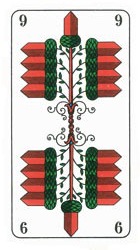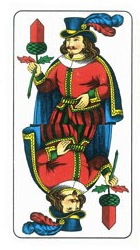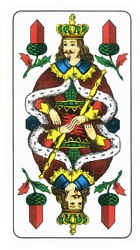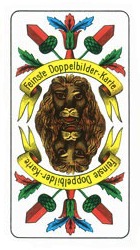Acorns (suit)
| Acorns | |
|---|---|
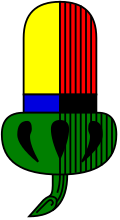 Symbol from Bavarian pattern | |
| Native name | German: Eichel |
| Decks | |
| Invented | 15th century |
Acorns (![]() ) (German: German: Eichel, or more unusually Hackl or Ecker) is one of the four playing card suits in a deck of German-suited and Swiss-suited playing cards. This suit was invented in 15th-century German-speaking lands and is a survivor from a large pool of experimental suit signs created to replace the Latin suits. Around 1480, French card makers adapted this sign into clubs in a French deck (known as clovers in France).[1]
) (German: German: Eichel, or more unusually Hackl or Ecker) is one of the four playing card suits in a deck of German-suited and Swiss-suited playing cards. This suit was invented in 15th-century German-speaking lands and is a survivor from a large pool of experimental suit signs created to replace the Latin suits. Around 1480, French card makers adapted this sign into clubs in a French deck (known as clovers in France).[1]
In English, cards are referred to as in a French deck (e.g. the "10 of Acorns"), but in German as Eichel-Zehn.
Acorns are the highest suit in the games of Skat, Schafkopf and Doppelkopf, but the lowest in Préférence. In Watten, the 7 of Acorns (the Spitz or Soach) is the third highest trump card.
The standard German-suited system of leaves, acorns, hearts, and bells appears in the majority of cards from 1460 onwards. There is no evidence for this system prior to this point.[1]
Acorns appear as one of four suits alongside crowns, bells, and shields in a set of mutilated cards possibly made in Alsace in 1480.[1]
Acorns appear as one of four suits alongside pomegranates[a], leaves, and flowers in a pack of cards (circa 1523) created by Hans Sebald Beham. The ranks go from 2 through 10 with three court cards: King seated on a horse, Ober, and Unter. Roman numerals are indexed at the top of the cards while Arabic numerals are indexed at the bottom.[3] Notably, all the pip cards have a central stem and there is a sow on the three of acorns; which later would migrate to the deuce when the 3-rank was dropped in later packs.
The standard four Swiss-German suits of shields, acorns, hawkbells, and flowers were found in playing cards inside a book cover (circa 1530) made in Basel. These cards feature the distinguishing banner replacing the 10-rank, and have the three court cards: King seated in a throne, Ober, and Unter.[4] This Swiss-German suit system is believed to have developed earlier with the earliest example dated between 1433 and 1451, though only cards from the shields suit survived.[5]
Gallery
[edit]German pattern
[edit]The gallery below shows a suit of Acorns from a German-suited deck of 32 cards. The pack is of the Saxonian pattern in which the seeds of the Acorns are red:
-
7
-
8
-
9
-
10
Swiss-German pattern
[edit]The following images depict the suit of Acorns from an 1850 Swiss-suited pack in which the seeds of the Acorns are yellow:
-
6
-
7
-
8
-
9
Individual cards
[edit]The following cards have special powers or names in certain games:
- Ober of Acorns - permanent top trump in Schafkopf, where it is known as the Old Man (der Alte)
- Unter of Acorns - permanent trump in Schafkopf and top trump in Skat.
- Seven of Acorns - one of the top three trumps in games like Watten, where it is called the Spitz ("tip" or "point")
Notes
[edit]- ^ The pomegranates suit appeared earlier in a 1496 modified Spanish-suited pack made by a south German engraver where the pomegranates replaced the coins suit. It possibly alludes to the kingdom of Granada.[2]
References
[edit]- ^ a b c Dummett, Michael (1980). The Game of Tarot. London: Duckworth. pp. 10–32.
- ^ Wintle, Simon (July 3, 1996). "South German Engraver". www.wopc.co.uk. The World of Playing Cards. Retrieved August 26, 2024.
- ^ Wintle, Simon (July 7, 2014). "Hans Sebald Beham". www.wopc.co.uk. The World of Playing Cards. Retrieved August 26, 2024.
- ^ Wintle, Simon (July 3, 1996). "Antique Swiss Playing Cards, c.1530". www.wopc.co.uk. The World of Playing Cards. Retrieved August 26, 2024.
- ^ Dummett, Michael (1980). The Game of Tarot. London: Duckworth. pp. 14–16.



